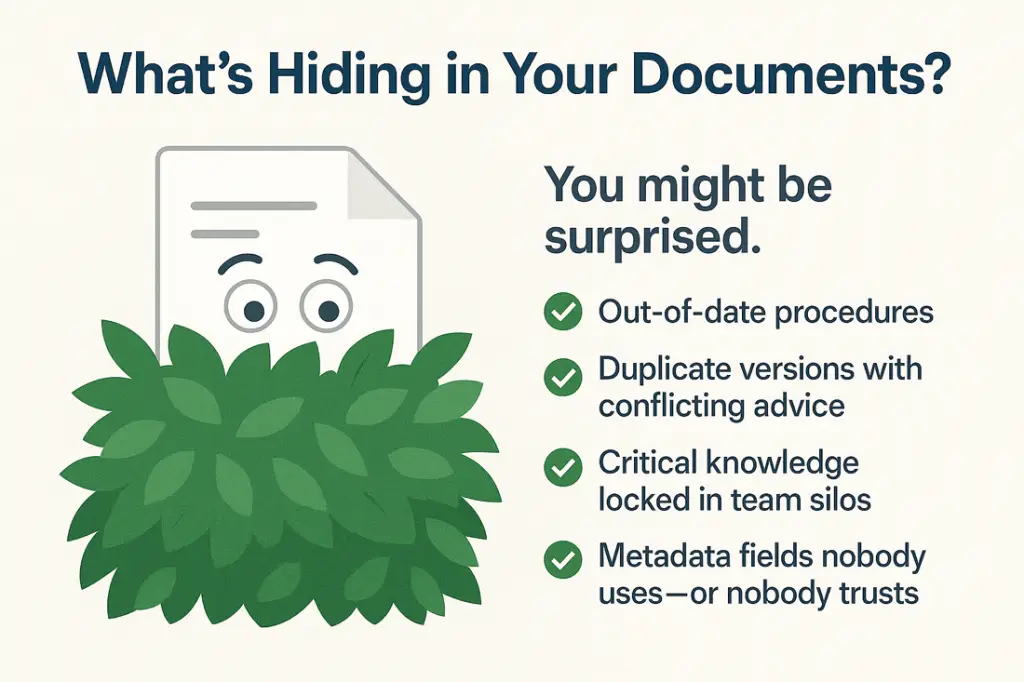
You Might Be Surprised
Many organisations don’t realise they have hidden problems with their content—until it costs them time, money, or reputation.
In the digital economy, everyone can be a content creator, and as a result, documents accumulate: policies, procedures, tech specs, templates, reports, and customer-facing materials. But left unmanaged, this content can become a liability instead of an asset.
Let’s take a closer look at what’s hiding in your document library—and why fixing it should be a priority.
1. Out-of-Date Procedures
Old content never really disappears. Unless you have a controlled process to archive or retire outdated material, chances are people in your organisation are still finding—and using—obsolete procedures.
This can lead to:
- Compliance failures
- Rework and wasted effort
- Frustration for employees following the wrong steps
- Potential risks to safety or customer experience
Regular content reviews and ownership assignment are essential to keeping your operational knowledge current and trustworthy.
2. Duplicate Versions with Conflicting Advice
How many versions of “the final version” are in circulation?
- Final.doc
- Final_v2.doc
- Final_v2_Approved.docx
- Final_v2_Approved_JimEdit.docx
We’ve all seen it. Multiple copies, emailed around or saved in different locations, lead to confusion about which one is actually correct. This problem escalates when outdated or unauthorised versions are acted upon by different teams.
It’s common for teams to create their own repositories—shared drives, wikis, or team sites—without linking them to the broader organisation. While this may seem efficient in the short term, it creates hidden silos of knowledge that aren’t accessible to the wider business
The solution is to establish a Single Source of Truth—a protected copy that is clearly authorised, with links from other systems pointing to it, so anyone needing it will access the up-to-date and approved version.
3. Critical Knowledge Locked in Team Silos
This creates problems such as:
- Teams duplicating work already done elsewhere
- Critical updates being missed across departments
- New employees struggling to find information
- Knowledge being lost when people leave
Bridging these silos with a connected content strategy ensures that what one team knows, the whole organisation can benefit from.
4. Metadata Fields Nobody Uses—Or Nobody Trusts
Metadata—labels like document type, owner, status, or audience—is a powerful tool to improve findability and governance. But only if it’s used properly.
Too often, organisations set up (or inherit) metadata fields that are:
- Irrelevant to users
- Inconsistent across libraries
- Poorly explained
- Incorrectly applied
As a result, users ignore them or misapply them, and trust in the system breaks down.
Effective metadata requires:
- Meaningful, user-friendly labels
- Training and guidance on how to apply them
- Ongoing governance to keep them consistent and relevant
Why This Matters to Your Business
You might be thinking, “We’ve always worked this way—why fix it now?”
Here’s why:
- Time Loss: Employees waste time hunting for the right document.
- Risk Exposure: People act on incorrect or outdated information.
- Compliance Gaps: Regulatory breaches due to unmanaged content.
- Reputational Damage: Customers receive inconsistent or wrong advice.
- Missed Opportunities: Valuable knowledge is hidden or lost.
What You Can Do About It
1. Run a Content Health Check
Audit your key repositories. Look for outdated, duplicated, or poorly labeled content. Identify your biggest risks.
2. Establish Content Ownership
Make sure every critical document has a named owner responsible for keeping it up to date.
3. Create a Single Source of Truth
Link all your systems, portals, and team sites back to a clearly identified master version of key content.
4. Simplify and Standardise Metadata
Review your metadata schema. Make sure it’s meaningful, easy to apply, and consistent across your libraries.
5. Promote User Awareness
Communicate the benefits of clean, managed content. Provide guidance and training on how to find and trust the right information.
How Texterity Can Help
At Texterity, we specialise in helping organisations take control of their content. From content audits and metadata design to content governance frameworks and user training, we help you clear the clutter and unlock the value hidden in your documents.
Let’s turn your document sprawl into business advantage.
